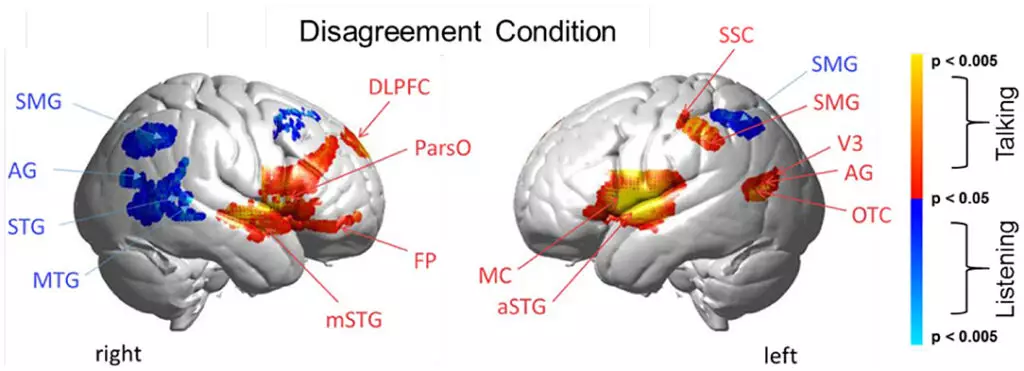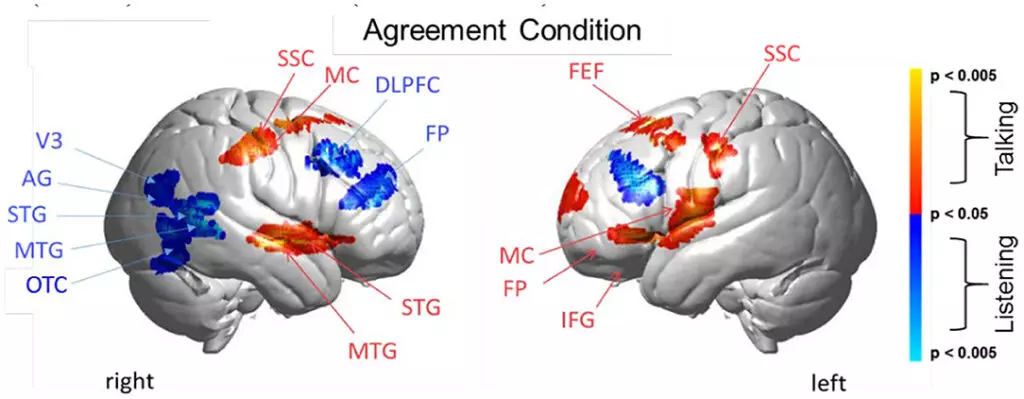
Everyday life is full of situations when we agree or do not agree with each other - whether it is a dispute with the boss on the quality of work done, talk about politics or religion with a friend, a quarrel with a loved one and so on. Although linguists have previously studied the behavioral aspects of such interactions, an understanding of how neural systems are adapted to discussions between people remain an open area of research.
The team of scientists from the Yale School of Medicine (USA) and University College of London (United Kingdom) conducted their own experiment. The results they presented in the Frontiers of Human Neuroscience magazine. The goal of work began to explore neural correlates when talking two people using functional neighboring infrared spectroscopy (neurovalization technology) and acoustic analysis of simultaneous audio recordings.
38 men and women participated in the study (average age - 23.7 years). They were asked using online surcharge to estimate their views on controversial topics, such as politics, ethics, philosophy, health and environment. The questionnaire contained 30 statements like "same-sex marriages is the civil law of each", "marijuana need to legalize", "the death penalty should prohibit" and "video games - a waste of time". Respondents were to note on a five-point scale how much they agree with each of the statements, as well as decide whether they were ready to discuss this topic or not. After analyzing the responses, participants were distributed to 19 pairs: in each of them, opponents were to agree on two topics, and on two more - on the contrary.
Then the pairs were offered to talk to four topics from the original questionnaire, but they were told about one directly before the start of the experiment. The order of answers and themes made random, and the opinions of each other did not know the participants.
"The paradigm was intended to simulate a spontaneous social situation, similar to the one when strangers can start a conversation, sitting next to the bus, and discover that they either agree, or disagree on a certain topic. The experiment consisted of four runs for three minutes. The roles of the "talking" and "listener" changed every 15 seconds, so all participants played the role of speaking during the six of the 12 total moves, "write the authors of the work.

Brain activity clusters represent conversation functions [speaking> listening] (red) and listening [hearing> conversation] (blue) / © Frontiers of Human Neuroscience
With the help of functional neighboring infrared spectroscopy, scientists recorded the activity of the brain of each participant. As it turned out, when a person agrees with the opponent, its brain activity is harmonious and concentrated on sensory areas, for example, in the visual cortex (part of the large hemisphey cortex, is responsible for processing visual information).

Brain activity clusters represent conversation functions [speaking> listening] (red) and listening [hearing> conversation] (blue) / © Frontiers of Human Neuroscience
However, during disputes, these areas of the brain turned out to be less involved, but the activity in the frontal share is the largest of the four major stakes of the brain, which is responsible for the conscious movements, the letter and the ability to talk - sharply increased.
"The Lobno-Dark Network, including Dorsolateral Preferontal Corra, Supramaginal Willow (part of the parietal bark, participates in the perception of oral and written speech. - Approx. Ed.), Angular and upper temporal winding, demonstrated increased activity in the situation of disagreement. On the contrary, the situation of consent was characterized by increased activity in networks responsible for their attention and perception: in the supervisional overhang, frontal fields of the eyes and frontal front areas, "scientists clarified.
"When we agree, synchronism arises in our brains," Professor Joy Hirsch commented on the conclusions. - But when you disagree, the neural connection is turned off. " According to him, an understanding and study of how consent or disagreements are functioning in situations or disagreement from the interlocutors, it is important in the current situation of social and political polarization.
Source: Naked Science
